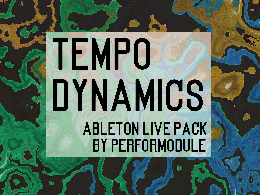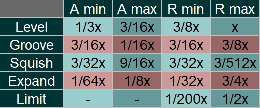
When applying dynamic effects, we are rarely going to need the entire timing ranges available, depending on the tempo, right? The new Tempo Dynamics pack provides go-to racks with minimum and maximum values hard-wired to ranges most potentially useful, given the chosen tempo — avoiding values that are likely too fast or too slow to be helpful.
Want to limit, squish, groovify, level, expand, or gate something? Reach for one of these racks in the nearest available tempo, and with handy knobs available to fine-tune, then dial it in quickly without worrying about the numbers or graphs… all while retaining the human element of your personal touch still in place. The macro knobs are also useful for automating in an arrangement, say to let something breathe more during one section and then clamp down during another.
I started devising these effect racks back when Live was still on version 9, so I’ve been testing them quite a lot over the last few years. They can be quite handy!
PACK CONTENTS
• 23 Tempo Compressors ranging from 20 to 240 bpm in 10bpm increments.
• 15 Tempo Expanders ranging from 25 to 235 bpm in 15bpm increments.
• 8 Tempo Gates ranging from 30 to 240 bpm in 30bpm increments.
• 12 Tempo Gluers ranging from 20 to 240 bpm in 20bpm increments.
• 23 Tempo Limiters ranging from 20 to 240 bpm in 10bpm increments.
• Bonus for Live 11: 23 Tempo Multibanders ranging from 20 to 240 bpm in 10bpm increments.
The Tempo Dynamics pack costs a paltry $12.
Grab it here from Isotonik Studios.
Tempo Compressors
Generally known for decreasing dynamic range, by adjusting the settings carefully, you can also acheive a sort of “reactive dance” feeling, which is more about imparting a sense of groovy movement.
MACROS:
Push squeezes the threshold down, increasing potential compression. Adjusting this carefully is paramount.
Low End Punch restores bass that may have been overly squashed, since low frequencies can tend to peak higher and eat up more headroom than others.
Level-Groove-Squish? selects mode:
“Level” is for overall, gradual smoothing. Might be good for pads, ambient soundscapes, or live broadcast.
“Groove” is for enhancing a sense of “3D life” by symbiotically responding to the integral vibe.
“Squish” is for your typical reduction of dynamic range by curtailing too-loud moments.
Breathe vs Clamp is your one-knob timing control, allowing transients to breathe more or less. Adjust it by feel.
Makeup Gain is for adjusting the level of the compressed signal (pre dry-wet).
Dry/Wet% makes it easy to implement in parallel and automate the amount.
To see the compression display, click “Show/Hide Devices” to unfold, then click the “Auto Select” arrow.
Tempo Expanders
The opposite of a compressor, an expander reacts to the same trigger signal, but instead of squeezing down on material that exceeds the threshold, it boosts those moments even more. Can be useful for re-invigorating overly flattened material, or to boost punchiness with minimal increase to the ambient noise floor.
MACROS:
Pull stretches the threshold down, increasing potential expansion. Increase loudness without boosting the ambient noise floor.
Attack v Sustain is your one-knob timing control, allowing to focus more or less on enhancing either the intial sharp transient, or the sustain that happens immediately thereafter.
Makeup Gain in this case, you’ll generally be pulling it DOWN to level-match to the dry signal, rather than up.
Dry/Wet% does that. Y’know.
Tempo Gates
That annoying noise in-between note hits, where it’s supposed to be silent. Pretend it doesn’t exist. Gate it.
MACROS:
Gate does that thing. The higher you lift it, the more stuff won’t be able make it through the gate.
Maintain allows more material to get through a triggered gate.
Soothe rounds off the behavior of the gating action, making it less choppy and more soft overall.
Makeup Gain is not usually necessary when using gates, but if you’re chopping out a lot of energy you might want to boost the average up a little to make up for it.
Tempo Gluers
“Pick, Drop, Push, & Blend”
Despite its distinction as classic “buss” style compressor, they are used on individual tracks all the time, due to their ease-of-implementation thanks to the stepped controls and generally tasteful, refined sound. You don’t even have to think about the timing controls for these. Just pick a tempo, drop the rack in, push it, gainstage it, and blend it. Done.
MACROS:
Push squeezes the threshold, increasing potential compression.
SoftClip Output? to more aggressively limit the output, if desired or needed.
Makeup Gain you know what that is for. At least you should by now.
Dry/Wet% yep mmhmmm.
Tempo Limiters
For these, the lookahead is based on the tempo, but the release is highly adjustable. Fairly fast default release times are given, but the adjustable range for each is quite versatile. Slower release times can lead to a cleaner (but not as loud) end result.
MACROS:
Push increases maximum potential limiting.
Recover determines how soon limiting stops after being engaged. A longer recovery time will result in a cleaner, more polite sound; a shorter recovery will result in a louder, more aggressive sound.
Stereo Link? can be turned off if desired, but that can result in some unnatural streo fluttering when wide-panned transients are mixed with sustained sounds. When to unlink? Probably not on busses or the master channel, but perhaps for certain types of stereo recordings, for instance an L-R mic pair that is somewhat dynamically off-balance.
Makeup Gain do i need to say it?
BONUS for LIVE 11!:
Tempo Multibanders
These are available only in the Live 11 version, and they use all sixteen possible macros.
MACROS:
The Pull macros increase maximum potential quiet-level dynamic behavior for the given frequency range (Low, Med, or High).
The Pull macros increase maximum potential loud-level dynamic behavior for the given frequency range (Low, Med, or High).
The Cutoff macros set the desired ranges of the frequency bands.
The Gate vs Comp macros determine whether (and how extremely) the quiet-level dynamic behavior is gating downwards or compressing upwards for the given frequency range.
The Comp vs Expand macros determine whether (and how extremely) the loud-level dynamic behavior is compressing downwards or expanding upwards for the given frequency range.
Chill vs Hype alters the timing controls.
Total Amount scales back the overall intensity.
NERDY JUNK
Segmentations of timing ranges for the presets were scaled in a way that made the most of the full available ranges of the native devices. These mathematically-derived scalings were then tested and fine-tuned thoroughly across various sorts of audio material to confirm their musicality and practicality when used at those bpms.

(x = tempo/60000)
Tip: Double Trouble! Sometimes, a clip might be warped to be shown as half or double the tempo that it actually “feels like” (for example, a dubstep or trap beat with a “double-time” hi-hat pattern). In a case like this, simply use the rack with double (or half) the clip’s shown tempo.
~`~
